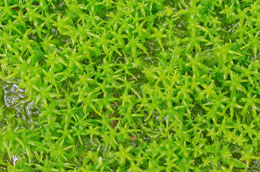Peat moss is nothing but the partially decomposed sphagnum mosses. Peat moss is largely used for soil amendment, and several other important purposes, which are discussed in this Buzzle article.

Peat moss is the partially decayed or decomposed mosses that belong to the genus,
Sphagnum. The genus
Sphagnum contains about 150 to 350 species of pale and ashy mosses that can be mostly found in peat bogs. Peat moss is basically known for its amazing absorbent quality, which makes it an excellent product for soil amendment.
Anyone interested in gardening and landscaping knows the importance of peat moss for soil conditioning, and soil amendment. It can ensure the healthy growth of your garden plants. The growing importance of peat moss has led to its cultivation in bogs across the world.
Uses of Peat Moss
As has been mentioned already, this product is mainly used for gardening and landscaping purposes. No one can beat this product when it comes to conditioning and aerating the soil. However, not many people know that peat moss has some medicinal uses, and it is used for electricity generation as well. It has also been used for a long time as a bedding material for livestock.
In Gardening and Landscaping
It can retain a large amount of water, just like a sponge. So, when added to soil, it increases the moisture level of the soil. Plants need soil with an adequate amount of water and air, in order to grow properly. They cannot grow in hard and dry soils, as their roots cannot develop properly.
Peat moss can loosen the hard soil by ensuring proper aeration. By retaining water for a long time, it helps keep the soil moisturized. Another important benefit of adding it to garden soil is that it helps retain nutrients in the soil, due to its ability to absorb and retain moisture. This in turn, helps improve the quality of the soil.
Livestock Bedding
It is quite an old practice to use peat moss as a bedding material for livestock. It has been in use for this purpose in Europe since the nineteenth century. What makes it ideal for livestock bedding is its ability to retain water. As it can absorb and hold a large amount of water, it helps keep the livestock dry. Apart from these, sphagnum mosses can reduce odor, which is another reason for using peat moss in livestock bedding.
As a Packaging Material
The production of peat moss generates a byproduct, which is termed as 'peat mold' or dust. This byproduct is used as a packaging material for fruits and vegetables.
In Electricity Generation
It was first used for electricity generation in1957. Presently, about 80% of the processed peat moss in Ireland is used for the production of electricity. In the Republic of Ireland, there are currently 6 energy stations where processed peat moss is crushed, and then burned to generate electricity. These specific energy stations meet almost 10% of the total energy requirement of the country. During the European petroleum crisis (In 1960s), these energy stations provided more than 40% of the total energy requirement of Ireland.
For Medical Purposes
It can be used for dressing wounds, due to its absorbent quality. It was used for this purpose by the Scottish soldiers in 1500s in the Battle of Flodden. Even during World War I, it was used for dressing wounds due to the shortage of cotton dressings. Due to its absorbent quality, peat moss was used in ancient times for making diapers and sanitary towels.
The juice extracted from peat moss is known to possess antiseptic properties, which can prove immensely beneficial for several skin conditions, including acne, scabies, psoriasis, insect bites, and eczema. Apart from these, it can inhibit the growth of certain types of bacteria. This benefit can be attributed to the presence of a carbohydrate extract, known as sphagnan.
In addition to these, peat moss can be used for filtering sewage. It can be used in septic systems for the purification of waste water.






 Peat moss is the partially decayed or decomposed mosses that belong to the genus, Sphagnum. The genus Sphagnum contains about 150 to 350 species of pale and ashy mosses that can be mostly found in peat bogs. Peat moss is basically known for its amazing absorbent quality, which makes it an excellent product for soil amendment.
Peat moss is the partially decayed or decomposed mosses that belong to the genus, Sphagnum. The genus Sphagnum contains about 150 to 350 species of pale and ashy mosses that can be mostly found in peat bogs. Peat moss is basically known for its amazing absorbent quality, which makes it an excellent product for soil amendment.